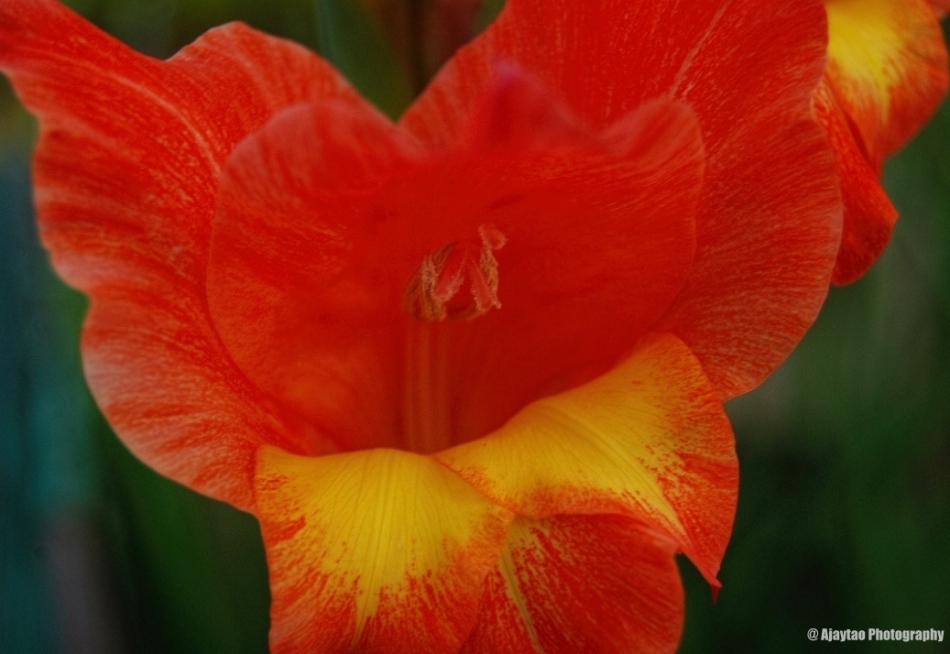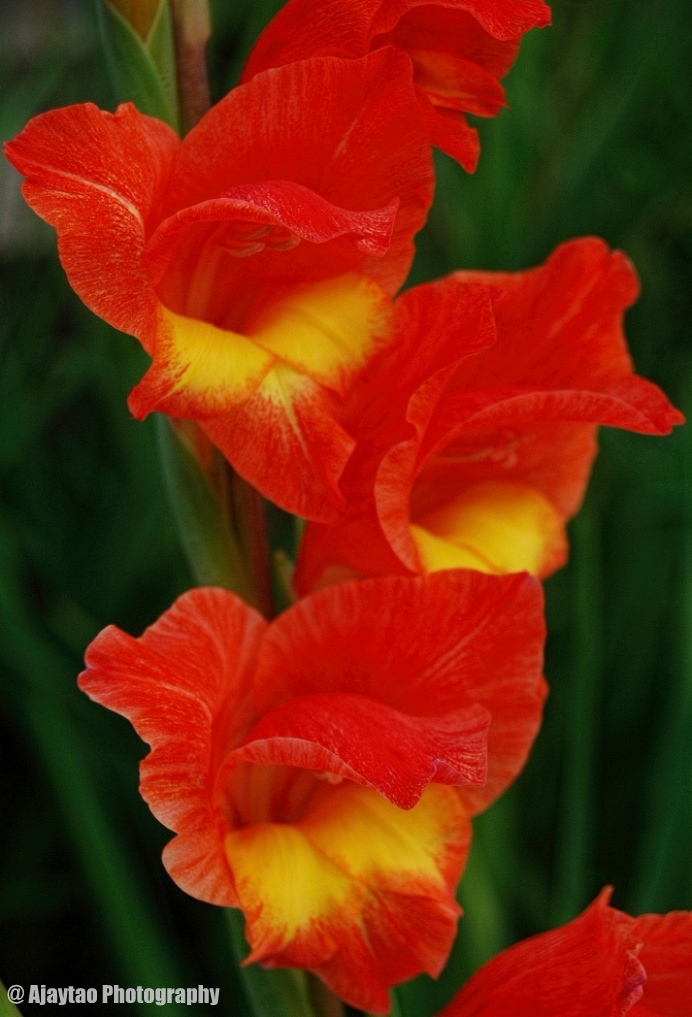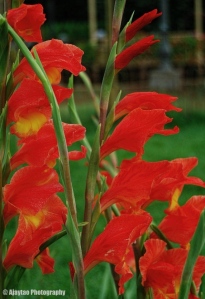Gladiolus dalenii – Sword Lily – Ajaytao
Common names: Flag flower, Gladiolus, Gladiole, Gladioluses, Gladioli, Sword Lily, Corn Lily, Natal lily, Dragon’s head lily, Parrot lily, African gladiolus, Afrikaans: Papegaai-gladiolus; Wildeswaardlelie, IsiXhosa: umnunge, IsiZulu: Isidwi Esibomvu; Udwendweni; Uhlakahle, Sesotho: Khahla-e-kholo, Spanish: Gladiolo, Estoque, French: Glaïeul, Italian: Gladiolo, Queen of Bulbs
Botanical name: Gladiolus dalenii / natalensis
Family: Iridaceae (Iris family)
Genus: Gladiolus
Species: Gladiolus communis L.
The genus Gladiolus contains about 260 species, of which 250 are native to sub-Saharan Africa, mostly South Africa. About 10 species are native to Eurasia. There are 160 species of Gladiolus endemic in southern Africa and 76 in tropical Africa. The flowers of unmodified wild species vary from very small to perhaps 40 mm across, and inflorescences bearing anything from one to several flowers. The spectacular giant flower spikes in commerce are the products of centuries of hybridisation, selection, and perhaps more drastic manipulation.
Gladioli are half-hardy in temperate climates. They grow from rounded, symmetrical corms, that are enveloped in several layers of brownish, fibrous tunics.
Their stems are generally unbranched, producing 1 to 9 narrow, sword-shaped, longitudinal grooved leaves, enclosed in a sheath. The lowest leaf is shortened to a cataphyll. The leaf blades can be plane or cruciform in cross section.
The flower spikes are large and one-sided, with secund, bisexual flowers, each subtended by 2 leathery, green bracts. The sepals and the petals are almost identical in appearance, and are termed tepals. They are united at their base into a tube-shaped structure. The dorsal tepal is the largest, arching over the three stamens. The outer three tepals are narrower. The perianth is funnel-shaped, with the stamens attached to its base. The style has three filiform, spoon-shaped branches, each expanding towards the apex. The flowers are bilaterally (as opposed to radially) symmetrical. Flower colors may be white, mauve, green, yellow, orange, red, pink or purple, often with blotches or stripes of another color. Some gladioli have scented flowers.
The ovary is 3-locular with oblong or globose capsules, containing many, winged brown, longitudinally dehiscent seeds. In their center must be noticeable the specific pellet-like structure which is the real seed without the fine coat. In some seeds this feature is wrinkled with black color. These seeds are unable to germinate.
These flowers are variously colored, pink to reddish or light purple with white, contrasting markings, or white to cream or orange to red.
The Gladiolus flower signifies remembrance. It also expresses infatuation, telling the receiver that he or she pierces the heart. It also stands for strength of character, faithfulness and honor.
Gladiolus are native to the mountains of South America. They are widely grown in India. Gladiolus are easy to grow, and are the favourite flowers in India for bouquets, hence their popularity. Blossoms come in a wide range of colors and bicolors, including blue. The blossoms will open from the bottom first. Harvest spikes of Gladiolus just before the top blossoms open. The top blossoms will open indoors.
Gladioli have been extensively hybridized and a wide range of ornamental flower colours are available from the many varieties. The main hybrid groups have been obtained by crossing between four or five species, followed by selection: Grandiflorus, Primulines and Nanus. They make very good cut flowers.
The majority of the species in this genus are diploid with 30 chromosomes but the Grandiflora hybrids are tetraploid and possess 60 chromosomes. This is because the main parental species of these hybrids is Gladiolus dalenii which is also tetraploid and includes a wide range of varieties (like the Grandiflora hybrids)
Growing/Planting
Gladiolus can be propagated by dividing rhizomes, tubers, corms or bulbs (including offsets).
Plant Gladiolus as early in the spring as the soil is fit to work.
Gladiolus corms can readily be purchased at your local garden center or nursery, though they can easily be grown from seeds.
Sow the seeds in early spring, in a well-drained flat 8 to 10 inches deep, that is filled with two thirds loam and one third leaf mold or peat moss, with a good amount of sand added.
Plant the seeds an inch apart and cover with about 1/4-inch of soil. If the soil is kept fairly moist, the seeds should sprout in a few weeks.
Set the container of seedlings outside in a fairly sunny location during the summer months and don’t disturb until the leaves have died down in fall.
At this time, take out the small corms, store for the winter, and plant in a border about 3 inches apart in March.
The blooming season can be stretched by making succession plantings, by planting bulbs of several sizes, and by using varieties which take different lengths of time to mature.
Gladioli Plant Care
Apply a 2 to 4-inch layer of mulch around the gladiolus to retain moisture and control weeds.
Water plants during the summer if rainfall is less than 1 inch per week.
Remove individual flowers as they fade, and cut back flower stalks once all flowers have gone by.
Leaves foliage intact to mature and rejuvenate the corm for next year.
Mulch beds with a layer of hay or straw for winter protection.
Remove excess soil, cut the stalks to within an inch of the corms and let them cure for 1 to 2 weeks in a warm, airy location.
Then remove and discard the oldest bottom corms and store the large, new corms in plastic mesh bags in a well-ventilated, 35 to 45 degree F room. Replant in spring.
The name “Gladiolus” is derived from the Latin word “gladius“, meaning “sword“, for the shape of its leaves. An ancient name for the gladiolus was “xiphium,” from the Greek word “xiphos“, also meaning sword. Gladiolus is also commonly referred to by the name of its genus – Gladiolus, the plural form of which can be Gladiole, Gladioluses or Gladioli. Gladiolus is also known as the Sword Lily, due to its sword shaped leaves, or Corn Lily. The gladiolus flower is the birth flower for August; it also represented the Roman gladiators.
Some Interesting Facts
An ancient name for the gladiolus was xiphium, from the Greek word xiphos, also meaning sword.
The Gladiolus flower is the birth flower for August.
Gladiolus represented the Roman Gladiators, before the African Gladioli became popular in the West.
African Gladioli were imported in large quantities to Europe from South Africa during the 18th century.
Most of the more than 10,000 named Gladioli cultivars probably were derived from just seven species native to South Africa and first brought to European gardens in the late 17th century.
The Mediterranean and British Gladiolus flowers were used to treat physical ailments.
The English used the gladiolus flower’s stem base (corms) as a poultice and for drawing out thorns and splinters; powdered corms mixed with goat’s milk were commonly used to soothe the symptoms of colic.
Scab, Fusarium Rot and Yellows, Penicillium Storage Rot, Leaf Spots and Blights, Stromatinia Corm Dry Rot, Virus and Phytoplasma Disease are the Common Gladioli diseases.
The Mancunian singer Morrissey is known to dance with gladioli, hanging from his back pocket or in his hands, especially during the era of The Smiths. This trait of his was made known in the music video for “This Charming Man”, where he swung a bunch of yellow gladioli while singing.
The Australian comedian and personality Dame Edna Everage’s signature flowers are gladioli, which she refers to as “glads”.
Gladioli are the flowers associated with a fortieth wedding anniversary.
“Gladiolus” was the word Frank Neuhauser correctly spelled to win the 1st National Spelling Bee in 1925.
Constituents:
Phytochemical analysis of aqueous extracts of corms yielded alkaloids, tannins, saponins, cardiac glycosides, flavonoids and carbohydrates.
Study of aerial parts of Gladiolus gandavensis isolated ten compounds: kaempferol, apigenin-7-O-alpha-L-rhamnoside, tamarixetin-3-robinobioside, nicotiflorin, astragalin-2″-O-beta-D-glucopyranoside, quercetin-3-O-(6″-O-Ecaffeoyl)-beta-D-glucopyranoside, beta-sitosterol, daucosterol, isopentylgentiobioside, and glycerol-alpha-monohexacosanate.
Study on three fractions of the bulbs of Gladiolus gregasius Baker showed that they all contained alcaloids, triterpenes, sterols, anthraquinones, glycosides and cardiac glycoside.
Edibility
Corms of Gladiolus dalenii are used as food in Zaire. Starchy croms are boiled and leached in water before consumption. Corm of G. edulis Burch also reported as edible.
Medicinal uses
Folkloric
• In sub-Saharan Africa, prescribed as a booster for patients with low energy and for hypochondriacs.
• In southern Africa, used for diarrhea and colds; a component of “lenaka.”
• In West Africa, used for both constipation and dysentery.
• In South West Nigeria, corms are used in treating gonorrhea, dysentery, and other infectious conditions.
• Corms ground to a fine meal to treat dysentery, diarrhea and stomach upsets.
• The Zulu use the corm of G. ludwiggi Pappe in making a medicine to facilitate placental passage. Corm decoction also used as enema to relieve dysmenorrhea.
• In southern Africa, corm used as remedy for impotency.
• In Ghana, corms are mixed with ginger as evacuant for constipation and dysentery.
• Decoction of corm used for rheumatic pains. source
• KwaZulu-Natal use an infusion of corms and lower portion of leaves for coughs and colds. Flower petals crushed into a ball rubbed onto nails to strengthen them.
• Infusion of petals warmed by the sun used as soothing wash for tired feet.
• Poultice of corms used to draw out splinters and thorns. source
• In the 17th century, the British used ground and powdered corm, mixed with goat’s milk, for colicky babies.
Gladiolus dalenii has been used to treat diarrhoea, chest ailments caused by sorcery, sterility in women, as good luck charms and in the horns used by inyangas / sangomas.
It is said the plant also helps in regulating the function of certain hormone in the prostaglandins family as resulting of liver function in balancing the levels of fatty acids. As we know unbalancing of fatty acids causes over production of some members in the prostaglandins hormone resulting in over active uterine muscles and menstrual cramps.
Gladiolus is said contains substance that helps to stimulate the production of testosterone which is essential for some women who have had symptoms of libido during menstrual cycle caused by low levels of testosterone in the body.
Ritual: In China, a flower for ceremonies and funerals; believed to help people find their way to their heaven.
Warning
Some parts of the Gladiolus plant are poisonous if ingested and handling some species may cause skin irritation or allergic reactions.
Gladiolus to be exceptionally invasive, spreading itself throughout my wild garden and coming up all over my garden beds. It is extremely difficult to eradicate as the corms produce dozens of bulblets which fall off easily when removing the plant and resulting in a group of small plants where there was only one. The plant also sends out underground suckers making removal even less effective. I do make sure that all flower heads are cut off before the seed pods dry out as the seeds also have a very high germination rate.
Ajaytao Photography






Recent Comments